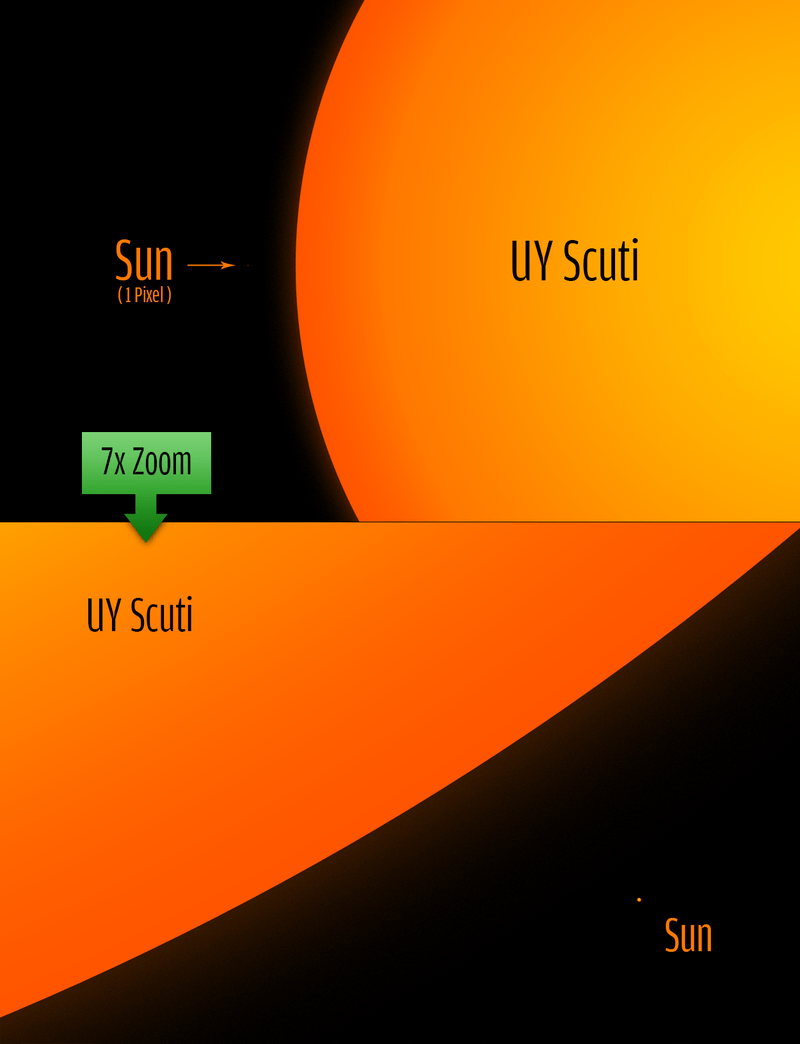UY Scuti – The Largest Star Ever Discovered?
What is The UY Scuti ?
UY Scuti (BD-12°5055) is a red supergiant star in the constellation Scutum. It is considered one of the largest known stars by radius and is also a pulsating variable star, with a maximum brightness of magnitude 8.29 and a minimum of magnitude 10.56. It has an estimated radius of 1,708 solar radii (1.188×109 kilometres; 7.94 astronomical units), thus a volume nearly 5 billion times that of the Sun. It is approximately 2.9 kiloparsecs (9,500 light-years) from Earth. If placed at the center of the Solar System, its photosphere would at least engulf the orbit of Jupiter.
Characteristics

UY Sct is a dust-enshrouded bright red supergiant and is classified as a semiregular variable with an approximate pulsation period of 740 days.
In the summer of 2012, AMBER interferometry with the Very Large Telescope (VLT) in the Atacama Desert in Chile was used to measure the parameters of three red supergiants near the Galactic Center region: UY Scuti, AH Scorpii, and KW Sagittarii. They determined that all three stars are over 1,000 times bigger than the Sun and over 100,000 times more luminous than the Sun. The stars’ sizes were calculated using the Rosseland radius, the location at which the optical depth is 2⁄3, with distances adopted from earlier publications. UY Scuti was found to be the largest and the most luminous of the three stars measured, at 1,708 ± 192 R☉ (1.188×109 ± 134,000,000 km; 7.94 ± 0.89 AU) based on an angular diameter of 5.48±0.10 mas and an assumed distance of 2.9±0.317 kiloparsecs (kpc) (about 9,500±1,030 light-years) which was originally derived in 1970 based on the modelling of the spectrum of UY Sct. The luminosity is then calculated to be 340,000 L☉ at an effective temperature of 3,365 ± 134 K, giving an initial mass of 25 M☉ (possibly up to 40 M☉ for a non-rotating star).
A hypothetical object travelling at the speed of light would be observed to take about seven hours to travel along UY Scuti’s great circle whereas it would take 14.5 seconds to circle the Sun.
Direct measurements of parallax of UY Sct by the Gaia Data Release 2 have recently given a parallax of 0.6433±0.1059 mas, yielding a much shorter distance of approximately 1.55 kiloparsecs (5,100 ly), and consequently much lower luminosity and radius values of around 86,300–87,100 L☉ and 755 R☉ respectively. However, the Gaia parallax might be unreliable, at least until further observations, due to a very high level of astrometric noise.
UY Scuti’s mass is uncertain, primarily because it has no visible companion star by which its mass can be measured through gravitational interference. However, it is expected to be between 7 and 10 M☉. Mass is being lost at 5.8×10−5 M☉ per year, leading to an extensive and complex circumstellar environment of gas and dust.
When considering star size, we are incredibly restricted with what we can’t measure – the vast majority of the universe’s stars lie outside of our galaxy, and are too far away to ever be measured. In spite of this, we have discovered some truly magnificent stars in our own backyard. Today, we will be looking at the biggest – UY Scuti. This magnificent titan of the cosmos is a staggering 2.3BN KM in diameter, and that is the least incredible of some of the numbers associated with it. Today, we will be analysing this star, and some of its close competition in the race for the largest star ever discovered.
Do not forget to share your opinion with us to provide you with the best posts !




0 Comments